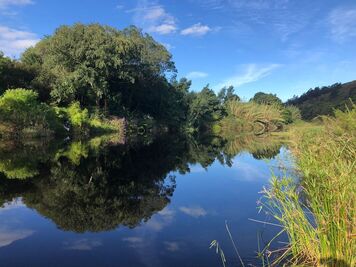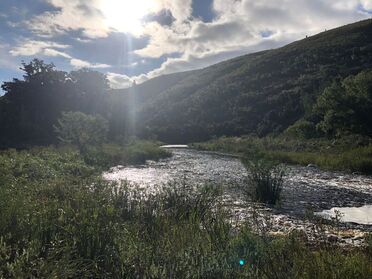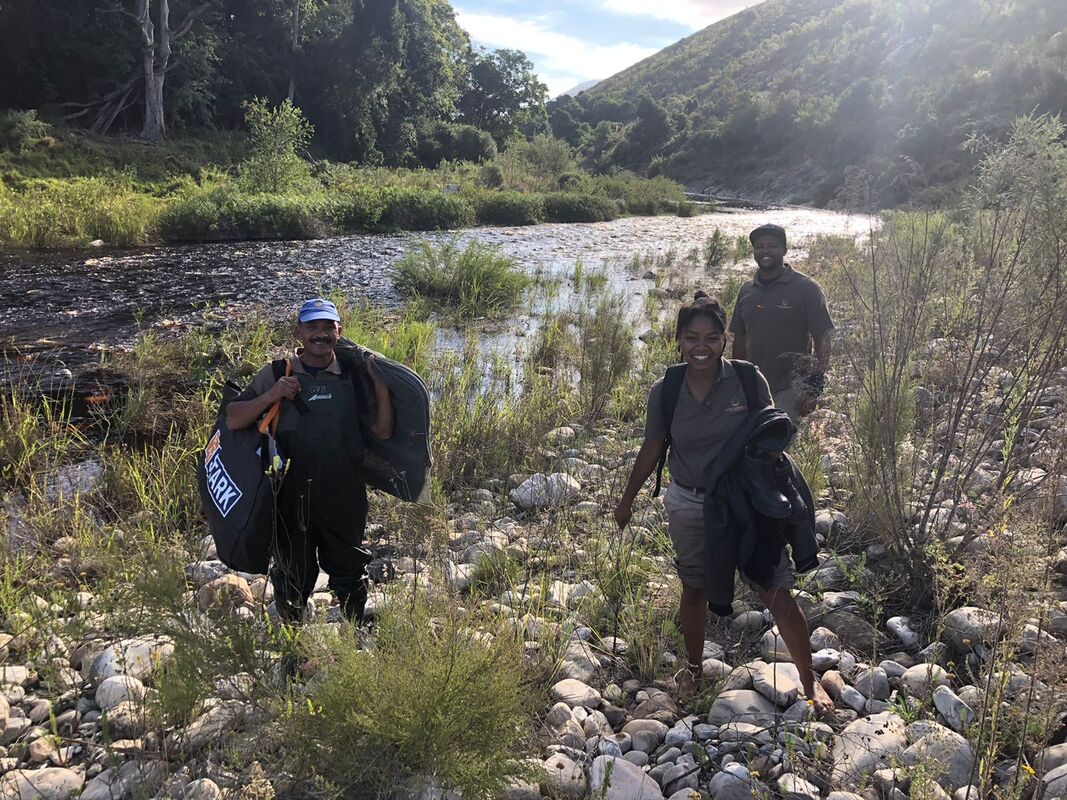|
GASPP (Grootvadersbosch Aquatic Species Protection Project) is a one-week survey, focusing on freshwater fish and macro invertebrate monitoring. During this week, our team works works with Cape Nature to better understand our river systems. It is also a fun week where we socialize with leading freshwater scientists. Fresh water is crucial for most life on earth. According to Vorosmarty.et al (2005) the current water withdrawal per year globally is approximately 3 600 cubic kilometres. Four out of every five people who live downstream of rivers are supplied by renewable freshwater services (Vorosmarty.,et al 2005). The GASPP project started in 2017 and is funded by the Table Mountain Fund. During the week survey, SASS (South African scoring system) is conducted on numerous river sites. In addition, nets are placed to record freshwater fish. We use the time to obtain useful Information on fish and macro invertebrates and explore several river sites in the conservancy. SASS (South African scoring system) SASS is used as a method to determine the health of the river by assessing the biota (Dickens and Graham, 2002). Macroinvertebrates are the basis for doing this. The SASS is completed by Jeanne Gouws who is a Cape Nature freshwater ecologist. She visited several sites per day to do SASS. During the SASS survey, nets are placed strategically along rivers to capture macro invertebrates and note them down. Once captured, they are identified and noted on a scoring sheet. In terms of health and safety regulations, Jeanne always wears waders when going into the river and avoids water that is flowing too quickly. SASS is based on the fact that macro invertebrates have different sensitivities to different levels of pollution. Some species are more sensitive than others. We also looked at the habitat availability of the macroinvertebrates.The more diversity in species you find, the higher the SASS score for that site. The more sub species of the same species you find, the higher the SASS score. For example, if you note more than one mayfly species, such as brushlegged mayflies as well as small minnow mayflies, the score will go up. Jeanne collects samples from different habitats: including rocks or boulders, gravel, vegetation and sand. She samples for set time intervals. “You collect for a set time so that when someone else comes to the same site on the same day, they could easily compare the data as the same periods were used.” explained Jeanne. We noted a range of different macro invertebrates, including worms, stoneflies, damselflies, caddisflies (cased and caseless), dragonflies, mayflies, bugs and beetles, snails, crabs, and other larvae. What amazing diversity! We also measured water quality. The velocity of the of the different streams was measured with a tool called the transparent Velocity Head Rod (TVHR) (WCR,2016). This tool is a transparent plastic board with a measuring ruler to estimate the flow velocity of the stream. Measurements of the width and dept of a particular stream needs to be measured and data can be used in a spreadsheet to calculate the area, discharge and velocity of the river. The pH of the water was also important as well as other aspect and questions such as:
Freshwater fish The two GVB Conservancy teams, with support from Cape Nature, placed nets in set sites in the rivers to note the presence and absence of freshwater fish. Alien fish are the primary threat to indigenous fish. In some river systems, they can have an economic value in terms of angling and aquaculture, but the management thereof is important (Jordaan and Skelton,2001). Without correct management of the Alien fish, the fish might escape from these farms and take over other river systems. Alien fish invasions can cause harm and contribute to indigenous freshwater fish becoming endangered. Alien fish that we found included catfish and blue gill that usually feed on invertebrates and small fish. We found lots of tilapia in the river, especially in the upper Tradouw River. It is possible to control the spread of alien invasive species. We as the public can prevent the spread of Invasive fish species by familiarise ourselves with the relevant legislation and not releasing fish into the rivers and not stocking or transporting fish without a permit (Jordaan and Skelton.,2001). The indigenous freshwater fish that were found included the Cape galaxia, which is a smaller fish. Its adult size is a maximum length of 75mm total length average length (Jordaan and Skelton, 2001). The Cape galaxia is usually widespread in the Cape floristic region and we found quite a lot in the river sites around the conservancy. We also found the Breede River redfin that usually grows up to 135mm in standard length (Jordaan and Skelton, 2001) and prefers rocky pools and is near threatened. The Tradouw redfin or Barrydale redfin is a redfin species that has an extremely small natural distribution range and is only found in the Tradouw river system and is critically endangered. Threats to the redfin fish include loss of habitat as well as predation by exotic fish. The Cape kurper was also found in some sites. The Cape kurper is another fish that can survive in a large variety of habitats. Eels are indigenous predators to redfin fish and the challenge is that they if they are trapped in the nets with the redfin fish, they will predate on the redfin. In order to avoid this, eel fences were placed in the nets which stops them getting into the nets and feeding on the fish. Eels are also fascinating creatures and they give an indication of a healthy, connected system as they show that the river is free flowing as eels breed in the ocean and move upstream. Other small challenges we had was that some sites were tricky to get too and require longer walks, especially the Tradouw river sites. Environmental education. The GASPP team visited Mullersrus primary school in Buffelsjags. Biodiversity was the topic and Dr Jordaan spoke to the class about pollution and protecting our rivers. She discussed how to take care of our rivers and why it is important to do so. She spoke specifically about freshwater fish. The class listened attentively and interacted nicely. After the talk, they were given an art assignment by Donovan Julius, a local Suurbraak artist. Donovan asked them to put their thinking down on paper or in art form. They later showed off their beautiful posters and ideas for the camera. They complied strictly to COVID 19 regulations and received sweets for good behaviour. Klein Pikkewyne preschool also visited the conservancy with little toddlers of four and five years old. They were 38 little ones. Ricardo Januarie spoke to them about fish and forests. Donovan was there and hands on with art and they had to draw and make posters in groups. They got the chance to see fish and then took a short hike through the forest patch near our office and came back for lovely juice and a sweet. As a conservation student, GASPP was a very fruitful and enlightening experience. I have new respect for conservation. It is not simple at all and there are so many aspects to consider. We had long days in the field and visited the most beautiful river sites, waterfalls, and weirs. I appreciated the experience, and I thoroughly enjoyed the interesting people. References
Dickens, C.W. and Graham, P.M., 2002. The South African Scoring System (SASS) version 5 rapid bioassessment method for rivers. African Journal of Aquatic Science, 27(1), pp.1-10. Freshwater fishes of the Cape floristic region (Martine Jordaan and Paul Skelton.Cape Nature).,2001. Matthews, S., 2018. Suite of tools help citizens take control of freshwater management. Water Wheel, 17(5), pp.24-27. Temple, J.L. (2004). The Musk Shrew (Suncus murinus), A Model Species for Studies of Nutritional Regulation of reproduction The Transparent Velocity Head Rod., WRC (Water Research Commission project 2016 No: K5\2350 Vörösmarty, C.J., Léveque, C., Revenga, C., Bos, R., Caudill, C., Chilton, J., Douglas, E.M., Meybeck, M., Prager, D., Balvanera, P. and Barker, S., 2005. Fresh water. Millennium ecosystem assessment, 1, pp.165-207.
0 Comments
Your comment will be posted after it is approved.
Leave a Reply. |
AuthorGVB Conservancy Staff Archives
May 2024
Categories |



 RSS Feed
RSS Feed






